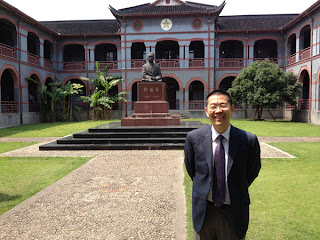 |
| EDS Travel Seminar at East China Theological Seminary |
The students hadn’t been
warned we were coming, and I felt a bit sorry for the students at the table
that Susan Taylor and I joined. We had been told that all the students spoke
English, and apparently some were quite fluent, but the man and two women at
our table didn’t speak much (although certainly more than my Mandarin!) We
struggled to communicate even a little. If Pui Lan hadn’t joined us and
translated it would have become very awkward very quickly.
A little bit of
background, China offers three levels of theological education. Nanjing Union
is the national seminary. It offers Bachelor’s and Master’s degrees. Five
regional seminaries, like the East China Theological Seminary we visited on
Tuesday, offer certificates and are closer to a specialized liberal arts college
education than what we think of as higher theological education. Then there are
provincial seminaries and bible schools (we won’t have a chance to visit one of
those). The students at our table had received their certificates from regional
seminaries and are spending two years at Nanjing to get their Bachelor’s
degrees. They will go back to their home areas and work as evangelists for
several years before ordination even becomes a possibility. (Evangelism is huge
in China, and worth a whole blog on its own!)
In some ways we have
much in common. One woman had a small child and was struggling with the same
issues of career and motherhood that many of us do. They have to pay for their
meals over and above tuition, which is 5,000 yuans (US$800), and had meal cards
just like we do (I wish I had brought mine so we could compare). We study many
of the same subjects, although I think they emphasize Bible studies more than
we do. They told us that New Testament studies are much more popular than
Hebrew Scripture—the latter is not considered to be as relevant or interesting.
We even read some of the same texts. The students at Gale Yee’s table were
studying the book of Judges and actually had her book Judges and Method in front of them. They were delighted to meet
her! During our tour of the library I went straight to the section on the Gospel
of Mark and I told the students at our table I found the same texts there that
Larry Wills assigned in his class. The Nanjing library isn’t bad, with fairly
large Chinese language and foreign language collections, although the English
language books at least are of very uneven quality. The regional East China
Seminary’s modern collection in any language is quite small, although they have
an interesting collection of older books that were rescued from destruction in
the Cultural Revolution.
Like us, these
students have regular chapel worship. At East China regional they have morning
prayer every day and at Nanjing they have morning prayer Monday, Wednesday and
Friday, and evening prayer every day. In both the students sit in assigned
areas with their classes, and I got the sense that chapel worship is mandatory.
All of the students
at the regional seminaries are young, and most at the national seminary are as
well. We learned that only last year did Nanjing remove the age limit of 30 for
admission to the Bachelor’s program and 35 for the Masters. Some students at
the regional seminary commute—the seminary has a special part time program that
offers a reduced level of education but does not require full time residence.
All of the students at Nanjing are residents in one of two dormitories, one for
men and one for women. Undergraduates live four to a room. Graduates get to
live only (only!) three to a room. Despite the heat in Nanjing, only the
building for the visiting foreign faculty is air-conditioned.
The students at both
levels of seminary don’t have field education placements like we do, instead,
in the summer they go back and work at their own church. With the exception of
some of the graduates of Nanjing who will become teachers, all will work in
churches. The regional seminary graduates tend to go back either to their own
church or to a church close to their own church. Nanjing Union holds a kind of
job fair in which representatives of churches all over China can come and meet
students to try to recruit them. Every graduate of both knows they will have a
job. They don’t have any kind of chaplaincies or other career paths. There is
such a lack of trained leaders that the churches need all of them. One of the
young women at our table, who comes from a rural part of central China, told us
that there are so few ordained ministers that many rural churches only have
communion once a year.
Perhaps most striking
to me, though, is the fact that all of these students are sent from their home
church. You can’t simply apply, as I did. The institutional church controls
access. I believe with all my heart that higher theological education should be
available to everyone. I also recognize that the openness of institutions like
EDS to people like me is a relatively new development in a country where
Christianity has been developing for over 300 years, and that this incarnation
of Christianity in China is quite new—only a bit more than 30 years in the
making. Maybe someday this seminary environment too will be more open.
Catherine Owens is a student
in the MDiv program at EDS.













